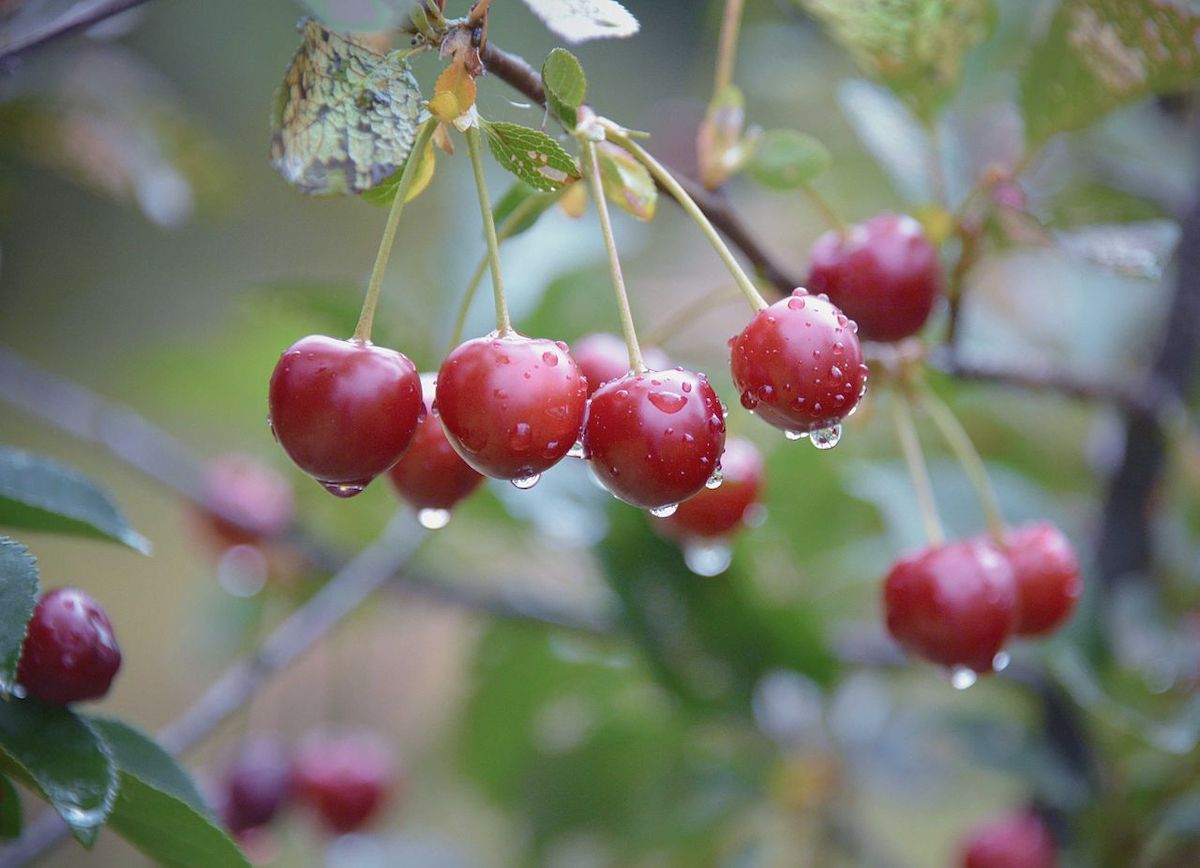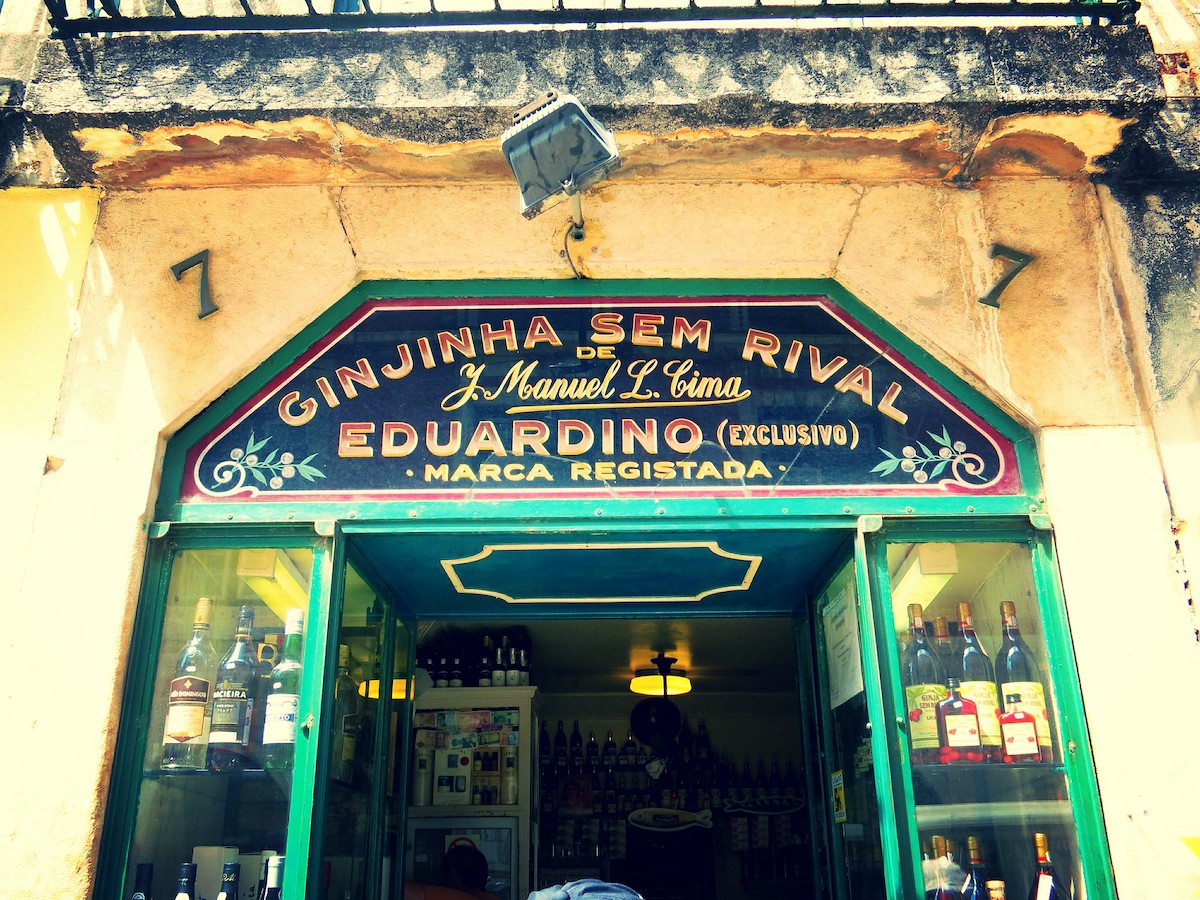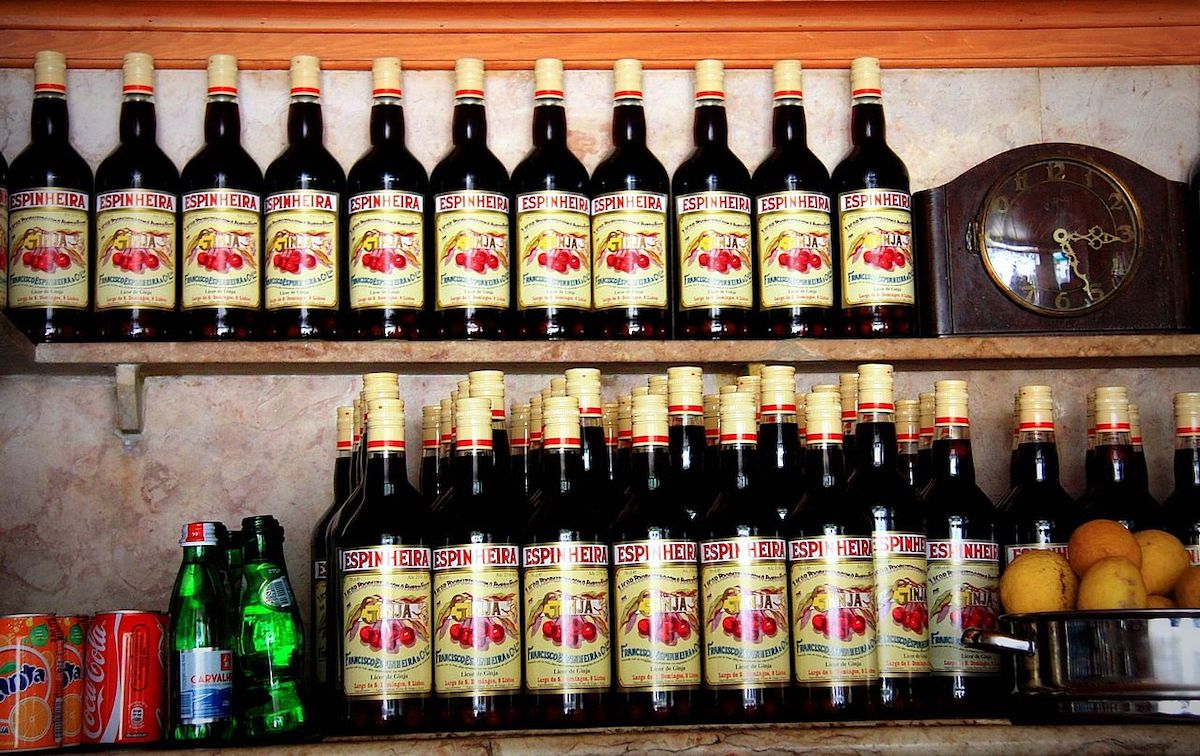Last Updated on November 29, 2025 by Emma Fajcz | Published: November 20, 2018
Portugal’s legendary cherry liqueur is sweet and strong, and is a fascinating traditional drink that you’ll want to try when you visit Lisbon. Here’s all about ginjinha and why you need to try it in Lisbon!

Why You Need to Try Ginjinha
Trying ginjinha in Lisbon is an essential travel experience. You’ll find this sour cherry liqueur on every list of local specialties to sample—and on the menu at countless bars, restaurants, and street stalls across the country.
Ginjinha is almost as iconic as pastéis de nata, and as much a cultural fixture as Lisbon’s azulejo tiles. It’s tasty, affordable, and undeniably emblematic of Portuguese culture. But beneath the surface of its obvious appeal, there’s much more to discover about this iconic drink. Once you know the full story of ginjinha, you’ll have even more reason to savor every sip.
What Is Ginjinha?
Ginjinha is a Portuguese liqueur made from aguardente (brandy or fortified wine) that’s been infused with sour cherries, sugar, and cinnamon. It’s dark red, super sweet, and surprisingly strong, with an ABV of around 18–24%.
Ginjinha is sometimes also called ginja, which can be slightly confusing since this word also refers to the fruit itself: a small red berry that’s highly acidic. In English it’s formally known as a Morello cherry. The word ginjinha may look like a mouthful, but it’s actually pretty simple. Try sounding out “jeen-jeen-ya” and people will probably know what you mean.
Fun Fact: Ginjinha is technically the diminutive form of ginja. So, it’s sort of like saying “a cute little sour cherry.”
Ginjinha is fairly easy to make; all you have to do is combine the ingredients in a bottle and then leave it alone for a matter of weeks or months. Today you can buy mass-produced ginjinha in supermarkets all over Portugal, but it’s also possible to find artisanal versions—or try making it yourself at home!

The History of Ginjinha
You could say it all began when the Romans brought ginja trees to Portugal in the first place. But just like the iconic custard tarts, ginjinha owes its existence to the church. Several centuries ago, a friar at Lisbon’s Igreja de Santo António decided to combine sour cherries, aguardente, sugar, and cinnamon and let it sit for a while—the same simple recipe used today.
Ginjinha was first sold to the public by a Galician named Francisco Espiñeira Couziño at his bar in Lisbon, A Ginjinha, which you can still visit. It quickly became a local favorite, and was even used as medicine to cure minor ailments (including for children!). In no time at all, it had cemented its status as a symbol of the city, and the country as a whole.
You’re not likely to find younger generations of locals clustered around ginjinha bars in Lisbon—it’s more of an old-timer thing—but these days even the most traditional places are capitalizing on the drink’s growing appeal. As the tourism industry in Portugal has exploded in recent years, ginjinha has become a popular draw for visitors of all ages (above 18, of course).

How to Drink Ginjinha
Despite the fact that it’s served in a shot-sized glass, many people insist that ginjinha is meant to be enjoyed slowly—not tossed back like a shot. Some people do prefer to down it in one gulp, but our advice is to start with a small sip to really experience it. The first things you’ll taste are the alcohol and sugar, but the sour cherry flavor will emerge if you take your time to savor it.
You can drink ginjinha at any time of day, including first thing in the morning. For some locals it’s a morning ritual, and a few of the oldest ginjinha bars in Lisbon still open as early as 7 or 8 a.m. They tend to be small, with just enough space for the bar and maybe a counter or a couple of tables to stand at.
At traditional ginjinha bars they’ll always ask you the same question: Com ou sem elas? This literally means “With or without them?”—“them” being the cherries that are bobbing around in the bottle. If you want a couple of these sour fermented fruits dropped into your glass, say “com elas.” Just make sure to watch out for the pits.
Local Tip: Bring a pack of hand wipes; this can be a sticky experience.

Where to Try Ginjinha in Lisbon
It’s not hard to find ginjinha in Portugal. Most restaurants and bars stock it. You’ll also see it on the shelves of supermarkets and specialty shops alike—but the best place to try it for the first time is at a traditional bar. Here are a few of our favorite places to drink ginjinha in Lisbon.

A Ginjinha
This was the first bar to sell ginjinha in Lisbon, and is a designated Loja Com História (historic shop). A Ginjinha has been pouring its signature sour cherry liqueur, Espinheira Ginja, since 1840.
It’s located in a large square close to the Rossio train station, right in the heart of downtown Lisbon. It’s open every day from 10 a.m. to 10 p.m. You can also pick up a whole bottle of ginjinha to take home, com ou sem elas (with or without cherries).

Ginjinha Sem Rival
Located just down the street from A Ginjinha, this is another of Lisbon’s original ginjinha bars. Ginjinha Sem Rival (which literally means “ginjinha without rival”) has been here for well over a century, and is also a Loja Com História.
In addition to its own brand of ginjinha, it sells Eduardino, a unique liqueur that combines ginja with anise and other aromatics. It’s named after a clown who used to frequent the shop in the early 1900s. Apparently, he came up with the recipe. Right then, in 1908, Eduardino became a registered trademark. In the bottle, you can see an illustration of his creator.
Local Tip: Order from the counter and then enjoy your drink at one of the high tables outside. Perfect for people watching.

Ginjinha da Ribeira
The name of this place refers to the fact that it’s set within the Mercado da Ribeira, a historic market in Cais do Sodré, that now houses the modern Time Out Market too.
Ginjinha da Ribeira has an outdoor seating area where you can sip your ginjinha and snack on other treats like pastries and sandwiches. Unlike the other two places on this list, here you can also get ginjinha in an edible chocolate cup (more on that below). It may not be as historic, but it’s a great choice if you want to sit down, relax, and maybe enjoy some other food and drinks as well.
Local Tip: Right next door you’ll find Manteigaria, one of the best places to try custard tarts in Lisbon.

Ginja de Óbidos
Although ginjinha is traditionally consumed on its own, there are plenty of other ways to serve it. The most common one was created in Óbidos, a town about an hour north of Lisbon that’s famous for its locally produced ginjinha (usually called ginja de Óbidos).
Several years ago, someone there had the idea to start serving it in edible chocolate cups meant to be devoured immediately after finishing the drink. This may not be very traditional, but it’s definitely delicious.
If you have time for a day trip from Lisbon, Óbidos is a great choice. It’s small enough to explore in just a few hours, and its pretty streets are lined with book shops and ginjinha bars selling the local specialty.
If you’re visiting in summer, see if your trip coincides with the annual Óbidos Ginja Festival, held in nearby Amoreira, and/or the whimsical Medieval Fair of Óbidos.
According to the official website of Óbidos, ginja should be served “as an aperitif or a digestive after-dinner drink, at a temperature between 15 and 17ºC (59 and 63ºF) or on hot days slightly chilled,” and adds that it “may be used in cocktails and cooking.”

Cocktails with Ginjinha
Many places in Portugal do indeed serve ginjinha-based mixed drinks, like the simple ginja tonic (ginjinha and tonic water). Another variation resembles a mojito, mixing the liqueur with mint, crushed ice, and soda water.
You’ll also find craft cocktails that make use of ginjinha. Lisbon’s renowned Red Frog Speakeasy has a signature drink called the Spiced Rusty Cherry that combines it with spiced rum, port wine, and cherry shrub. And at the beautiful Gin Lovers Bar & Restaurant, you can try Gin Já—a mix of gin and ginja in one bottle—in a cocktail with lime tonic, cinnamon, and lemon.

Where to Buy Ginjinha by the Bottle
A bottle of ginjinha makes for a fantastic souvenir from Lisbon, and a great gift—but where should you buy it?
We suggest either grabbing a bottle straight from one of the three bars mentioned above. Another option is going to a supermarket or gourmet shop. Choose an authentic brand like Espinheira, Mariquinhas, or Vila das Rainhas to ensure the highest quality. All of these are widely available at stores around Lisbon.

How to Try Ginjinha When You’re in Lisbon
You can’t leave Lisbon without trying ginjinha. We’ve got you covered on our Tastes & Traditions of Lisbon Food Tour, which includes a stop at one of our favorite ginjinha bars. Try it for yourself and decide whether you’re team “com elas” or team “sem elas”! You’ll also enjoy two other drinks and 9 tastes, all from small businesses in Lisbon.

Featured Review: Tastes & Traditions of Lisbon Food Tour
⭐⭐⭐⭐⭐ “Super guide – Natalia – really made the tour very interesting with her stories and friendly, knowledgeable anecdotes. Variety of foods sampled was substantial. Best “foodie” tour I’ve been on! Great way to get the true feeling for the Portuguese people and their culture.”
– Carol on Tripadvisor
Ginjinha in Lisbon FAQs
What does ginjinha taste like?
Ginjinha has a sweet, tart, and slightly warming flavor. It tastes like a blend of sour cherries, cinnamon, and a hint of clove, with a smooth, liqueur-like finish. The balance of fruitiness and spice makes it both cozy and refreshing!
What type of alcohol is ginjinha?
Ginjinha is a Portuguese cherry liqueur made by infusing sour cherries (ginja) in alcohol, typically aguardente (a clear grape brandy), along with sugar and spices. It’s usually around 18–24% ABV. This drink is traditionally served as a small shot with a cherry at the bottom.
How do you pronounce ginjinha?
Ginjinha is pronounced “zheen-ZHEEN-yah.” The zh should sound like the “s” in “measure”, and be sure to accent the second syllable.
Can you get ginjinha in the US?
Yes, you can sometimes find ginjinha in the US, but availability varies. Some specialty liquor stores and Portuguese markets carry imported bottles, and a few online retailers ship it domestically. However, the selection is far more limited than in Portugal, so tasting it at a traditional Lisbon ginjinha bar is still the best experience.








